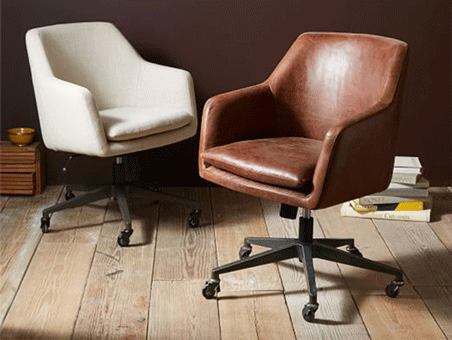Furniture Arrangement Tips for a Welcoming Reception Area
First impressions matter, and your reception area is often the first point of contact for visitors, clients, and employees when they enter your business or office space. A well-designed and welcoming reception area can set the tone for the entire experience, creating a positive and lasting impression. One of the key elements of creating an inviting reception area is the arrangement of furniture. In this blog, we will explore various furniture arrangement tips to help you design a reception area that radiates warmth and professionalism.

Define the Purpose
Before diving into arranging furniture, it's essential to define the purpose of your reception area. Is it a space for welcoming clients and guests, a waiting area, or a multifunctional zone? Understanding the primary purpose will guide your furniture choices and layout. For example, a waiting area may prioritize comfortable seating, while a corporate office reception area may emphasize a professional and organized look.
Balance Aesthetics and Functionality
A welcoming reception area should balance aesthetics and functionality. While it's crucial to create an attractive space, it's equally important that the furniture serves its purpose. Consider the number of people you expect to accommodate and the types of tasks they may perform in the reception area. Opt for furniture that not only looks good but also offers comfort and practicality.
-
Furniture Selection
When selecting furniture for your reception area, choose pieces that reflect your brand identity and create a cohesive design. Here are some furniture elements to consider:
-
Seating: Comfortable seating is a must. Choose chairs, sofas, or benches that provide ample support and cushioning. If space allows, mix and match seating options to accommodate different preferences and needs.
-
Reception Desk: The reception desk is often the focal point of the area. Ensure it is functional, well-lit, and represents your company's style. It should also be positioned to allow staff easy visibility and access to the entrance.
-
Tables: Coffee tables or side tables provide a place for guests to set down items like magazines, laptops, or coffee cups.
-
Storage: Consider adding storage solutions like cabinets or shelves to keep the area clutter-free and organized.
-
Layout Options
There are various layout options to consider when arranging furniture in your reception area. The choice depends on the size and shape of the space, as well as your specific needs:
-
Open Layout: An open layout is suitable for larger spaces and creates an airy and welcoming atmosphere. It allows for easy movement and interaction among visitors.
-
Linear Layout: A linear layout places furniture in a straight line along one or more walls. This arrangement works well in narrow spaces, making efficient use of available room.
-
Circular Layout: Circular layouts arrange furniture in a circular or semi-circular pattern, often with a central point of focus. This arrangement promotes conversation and engagement.
-
Group Seating: Group seating is ideal for creating intimate seating areas within a larger reception space. Clustering chairs or sofas around a central table or focal point can foster a sense of cosiness.
-
Modular Furniture: Modular furniture allows for flexibility in the layout. Pieces can be rearranged or combined as needed to adapt to various functions or group sizes.
-
Consider Flow and Traffic
Efficient flow and traffic management are crucial for a functional reception area. Avoid cluttered or cramped spaces that hinder movement. Ensure that pathways are clear and unobstructed. Consider the position of the reception desk and its accessibility from the entrance, and arrange seating to allow for easy navigation.
-
Lighting
Proper lighting can make a significant difference in the ambience of your reception area. Natural light is preferable, as it creates a warm and inviting atmosphere. However, if natural light is limited, invest in well-designed artificial lighting. Use a combination of ambient, task, and accent lighting to create a welcoming and visually appealing space.
-
Colour Palette
Selecting an appropriate colour palette for your reception area can significantly impact the overall feel of the space. Consider your brand colours and the emotions you want to evoke. Neutrals like beige, grey, and white can provide a timeless and versatile backdrop while adding pops of your brand's colours through accents or furniture can create a vibrant and memorable impression.
Also Read | The History of Office Furniture: From Antique Desks to Modern Workstations
-
Decor and Accessories
Enhance the welcoming atmosphere by incorporating decor and accessories. Artwork, plants, decorative cushions, and area rugs can add warmth and personality to the space. Ensure that your choice of decor aligns with your brand and the reception area's overall design.
-
Personal Touch
To make your reception area even more inviting, add a personal touch. This could include a welcome sign, a small refreshment station with coffee and water, or custom branding elements that reflect your company's identity. These details can make guests feel appreciated and valued.
-
Regular Maintenance
Lastly, ensure that your reception area remains inviting by implementing a maintenance plan. Regularly clean and inspect furniture, replace worn-out or damaged items, and update decor as needed. A well-maintained reception area is a testament to your commitment to creating a welcoming environment.
Conclusion
Designing a welcoming reception area through thoughtful furniture arrangement is a powerful way to make a positive first impression on clients, guests, and employees. The key is to strike a balance between aesthetics and functionality, considering the purpose of the space, furniture selection, layout, lighting, colour palette, and personal touches. By following these tips, you can create a reception area that radiates warmth, professionalism, and a lasting positive impression for anyone who enters your space.
- 25.10.2023
-
Category:
- Lounge Chair